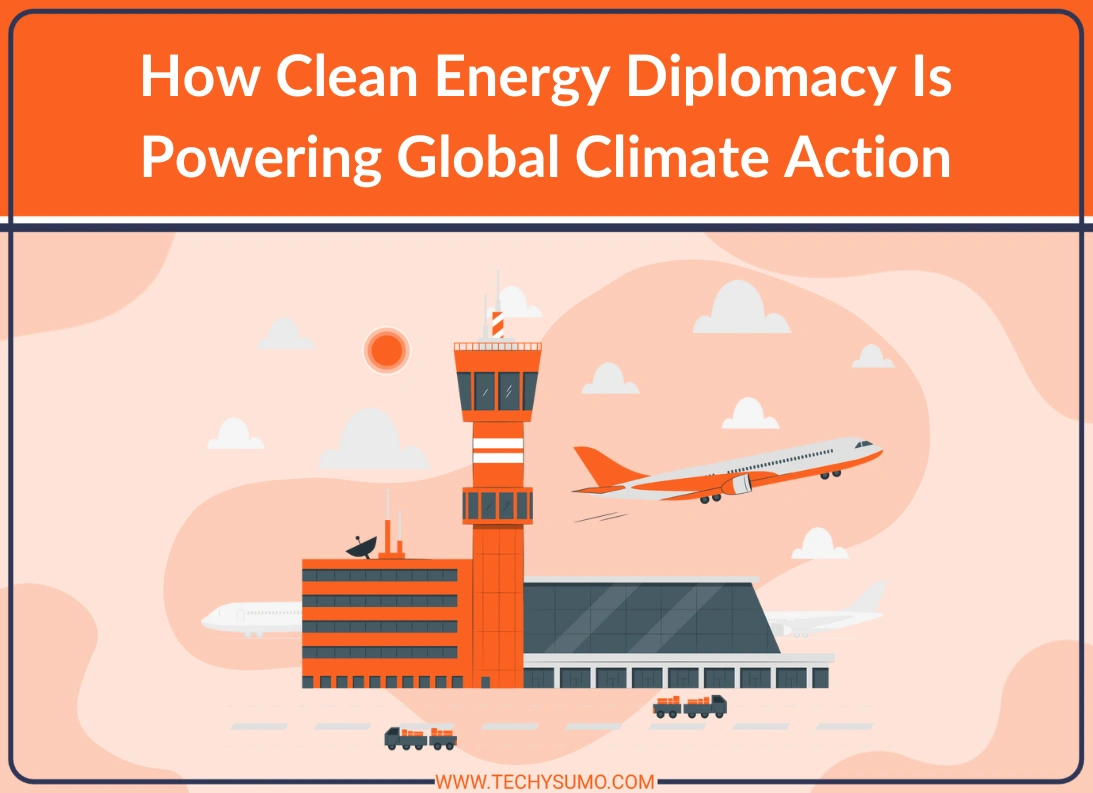As climate change accelerates, the path to achieving net-zero emissions depends on one essential factor — cooperation. No single nation can transition to clean energy in isolation. The global energy landscape is deeply interconnected, and clean energy diplomacy is now redefining how countries collaborate to meet their climate goals.
You’re living in an era where traditional energy diplomacy — once focused on oil, gas, and pipeline access — is rapidly giving way to alliances centered on Clean Energy and Sustainability Ties. These diplomatic connections merge science, technology, and policy to speed up the adoption of renewable energy worldwide.
Table of Contents
- What Is Clean Energy Diplomacy?
- Key Tools & Mechanisms in Clean Energy Diplomacy
- Drivers & Imperatives for Clean Energy Diplomacy
- Challenges & Risks in Clean Energy Diplomacy
- Case Studies & Global Examples
- The Role of Clean Energy and Sustainability Ties
- Strategies for Effective Clean Energy Diplomacy
- Conclusion
What Is Clean Energy Diplomacy?
Evolution from Fossil Fuel Era Diplomacy
Historically, energy diplomacy revolved around fossil fuels — securing oil reserves, negotiating gas pipelines, and maintaining geopolitical influence. But as global priorities shift toward decarbonization, this approach has become outdated. Fossil fuel-based relations no longer align with the urgency of the climate crisis.
Defining Clean Energy Diplomacy
Clean energy diplomacy refers to the use of diplomatic tools — from treaties and trade to finance and technology partnerships — to promote renewable energy, energy efficiency, and climate cooperation. It aligns energy policies with climate objectives, driving sustainable development through international collaboration.
At its core, clean energy diplomacy bridges three goals: energy transition, economic development, and environmental protection.
Also Read
Key Tools & Mechanisms in Clean Energy Diplomacy
Financial Instruments & Green Finance
The heart of clean energy diplomacy lies in financing. Governments and multilateral institutions are channeling billions into renewable energy through green bonds, export credits, and development aid. Initiatives like the Clean Energy Transition Partnership (CETP) redirect public finance away from fossil fuels toward renewables, signaling a clear diplomatic shift.
Technology Transfer & Capacity Building
Another cornerstone of clean energy diplomacy is technology sharing. Wealthier nations and private sectors collaborate with developing countries to share innovations in solar, wind, battery storage, and smart grid infrastructure. This not only accelerates the global clean transition but also builds capacity in regions where energy access remains limited.
Trade & Standards Agreements
To make clean technologies accessible and affordable, international agreements are working to harmonize standards. Examples include carbon border adjustment mechanisms, green trade tariffs, and sustainability-focused trade pacts. These frameworks ensure fair competition while promoting environmental responsibility.
Strategic Infrastructure & Connectivity
Diplomatic cooperation also extends to building cross-border energy infrastructure — like regional renewable grids or hydrogen corridors. For example, interconnectors between European and African nations allow renewable energy sharing, strengthening mutual energy security while supporting sustainable development.
Drivers & Imperatives for Clean Energy Diplomacy
Urgency of the Climate Crisis
With the global carbon budget shrinking, countries must decarbonize power, transport, and industry faster than ever. Clean energy diplomacy provides a mechanism for collective action, ensuring global efforts align with science-based targets.
Geopolitical Shifts in Energy
As the influence of oil and gas wanes, renewable technologies and critical minerals are emerging as the new geopolitical currency. Nations rich in lithium, cobalt, and rare earth elements are now central to global supply chains — redefining global alliances.
Economic and Development Incentives
Clean energy is not just a climate solution; it’s an economic growth engine. Investing in renewables drives job creation, innovation, and industrial competitiveness, while ensuring that developing nations benefit from a fair and inclusive energy transition.
Pressure to Reorient Public Finance
Countries are under growing pressure to end public financing of fossil fuels. Redirecting funds toward renewables, green infrastructure, and low-carbon industries is both a moral and economic necessity — and diplomacy is the bridge that makes it possible.
Challenges & Risks in Clean Energy Diplomacy
Competing Strategic Interests
Despite global consensus on climate goals, countries often prioritize national interests — whether in trade, energy security, or political influence. These tensions can slow progress toward unified clean energy objectives.
Imbalance in Funding and Commitments
While many nations have cut fossil fuel investments, clean energy financing hasn’t scaled up fast enough. This creates funding gaps that limit progress, especially in emerging economies.
Technology Lock-In & Dependency
Reliance on foreign clean technologies or critical mineral imports can create new dependencies, shifting the balance of power rather than eliminating it. Ensuring equitable technology access remains a key diplomatic challenge.
Governance and Accountability
Diplomatic agreements only work if countries follow through. Monitoring progress, verifying emissions cuts, and maintaining trust are ongoing challenges in clean energy diplomacy.
Case Studies & Global Examples
Clean Energy Transition Partnership (CETP)
Launched by a coalition of countries, the CETP redirects billions in public finance from fossil fuels to renewable projects. This model demonstrates how international cooperation can align financial systems with climate goals.
EU Green Diplomacy
The European Union has made clean energy a cornerstone of its external relations, linking foreign policy, climate, and trade. Its Green Deal diplomacy supports renewable energy investments in Africa, Asia, and Latin America.
U.S. Clean Energy Diplomacy
The U.S. Bureau of Energy Resources leads initiatives to strengthen clean energy supply chains and promote sustainable energy policies abroad, including through partnerships with China and allies on critical minerals and technology standards.
China’s Global Renewable Expansion
China’s diplomacy now integrates renewable energy exports, infrastructure financing, and capacity-building in developing nations — particularly across Asia and Africa. This approach positions clean energy as both a diplomatic and economic priority.
The Role of Clean Energy and Sustainability Ties
At the heart of this global transformation are Clean Energy and Sustainability Ties — partnerships that unite nations through shared commitments to climate action, green trade, and renewable energy cooperation.
These alliances encourage joint research, investment in clean technologies, and policy harmonization. The collaboration between Norway and China illustrates how bilateral agreements can promote innovation and sustainable growth while tackling global energy challenges. By covering these developments. Tech Pioneer helps turn ambition into action, advancing impact through awareness and shared insight. Such ties are essential to ensure that the clean energy transition remains coordinated, inclusive, and resilient.
Strategies for Effective Clean Energy Diplomacy
To make clean energy diplomacy work, nations and institutions can:
- Align national and diplomatic climate strategies to ensure consistent goals.
- Increase transparency in funding and emissions reporting.
- Scale up public and private finance for renewable energy.
- Promote just transitions to protect workers and communities.
- Strengthen global coordination through organizations like the UN, IEA, and World Bank.
- Invest in diplomatic training to build expertise in clean energy negotiations.
Conclusion
The transition to clean energy is no longer a technical issue — it’s a diplomatic one. Through Clean Energy and Sustainability Ties, nations are redefining how global cooperation works. These partnerships connect policy, finance, and innovation in ways that make climate goals achievable.
While challenges persist, clean energy diplomacy is rapidly becoming one of the most powerful tools for achieving global sustainability. By engaging in these efforts, countries can not only meet their own targets but also shape a more equitable, resilient, and sustainable energy future for all.






